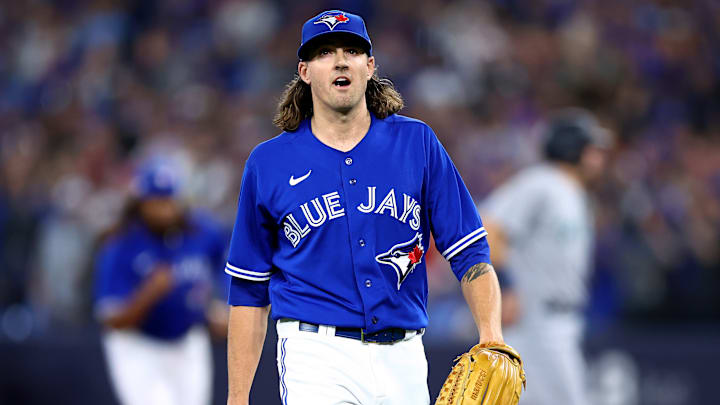In a recent piece by Kaitlyn McGrath of The Athletic, Kevin Gausman was named as the key to the Toronto Blue Jays' rotation for the upcoming season.
Heading into the 2023 season, the Blue Jays have assembled one of the best starting rotations in the American League and - as McGrath points out - the projections back that up. At FanGraphs, the Jays' rotation ranks fifth in projected WAR.
As things currently stand, the rotation is set to look something like this:
1.) Alek Manoah
2.) Kevin Gausman
3.) José Berríos
4.) Chris Bassitt
5.) Yusei Kikuchi
There's no arguing against the talent on the staff. What matters most is how it's going to utilize this talent and potential. Berríos is a former annual All-Star for the Twins who lost his way last year. Kikuchi has yet to find any long-term success in the majors and struggled immensely last season.
Bassitt is the lone newcomer on this year's starting five and he is sure to represent one of the best No. 4 starters in all of baseball, so long as he is able to replicate his successes from the past few years.
We all know what Manoah is about and what he brings to the table. He looked like an ace-in-the-making in a 20-game showing in 2021 but broke out in a big way last year. He went 16-7 with a 2.24 ERA, making the All-Star Game and finishing third in the AL Cy Young Award voting.
Then, there's Gausman. The 32-year-old veteran is named by Eno Sarris as the key to the rotation. Per Sarris, Gausman's 80th and 20th percentile projections label him as the Jays pitcher with the second-highest upside on the entire team.
Thanks to some ups and downs over the course of his career (including multiple seasons of 5.00+ ERAs and one with an ERA under 3.00), Gausman's upsides and downsides vary pretty dramatically. Sarris points to his lowered home run rate thanks to a new approach with his fastball as one of the reasons for his recent success.
Per Sarris, Gausman changed a few things with his fourseam fastball in the COVID-shortened 2020 season like aiming higher at the plate and releasing the ball closer to home plate. This makes the ball appear to be coming at hitters faster and successfully threw them off that year and in each one since.
Sarris created Pitching+, which is a new statistic that takes the physical properties of a pitch (he calls this Stuff+) and its count, as well as pitch-type-adjusted locations at the plate (what he calls Location+) to better judge a pitcher's performance on the mound.
These stats use 100 as "league-average", just like OPS+ and wRC+ for hitters and ERA+ for pitchers.
Last year? Gausman's Pitching+ was at 110 (close to Shane McClanahan and Zack Wheeler per Sarris), his Stuff+ was at 110 as well and his Location+ was at 107.
When I spoke with Sarris about a possible leaderboard with sortable statistics on it consisting of Pitching+ he said that such a thing is not available ... yet.
Sarris and McGrath point out that while an implosion by Gausman and/or Berríos will not be good for anyone in 2023, there are capable arms behind them that can succeed if given the chance. Believe it or not, this includes names like Yusei Kikuchi, Mitch White, Thomas Hatch and Nate Pearson.
Gausman has experienced some high highs and some low lows over the course of his decade-long career in the majors. He is capable of greatness and he has, in the distant past, also been capable of imploding on the mound. For what it's worth, underlying stats like Stuff+ suggest that both him and Berríos are closer to their highs (80th percentiles) than their lows (20th percentiles).
Should the Blue Jays get the 2021 version of Gausman, the one that served as a true co-ace on the staff, things are looking good for this team in the upcoming campaign.
